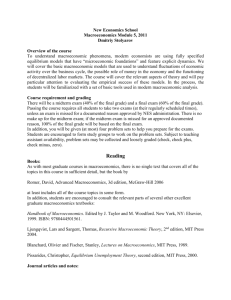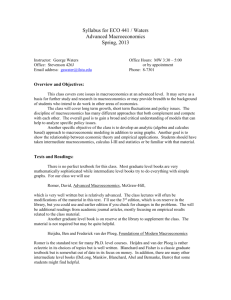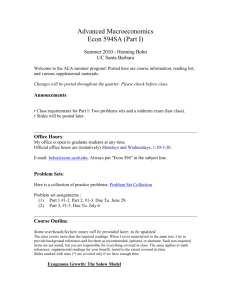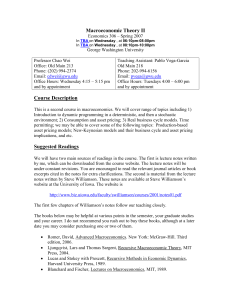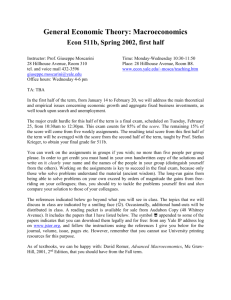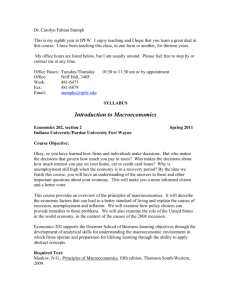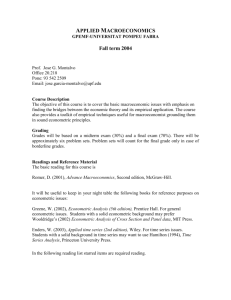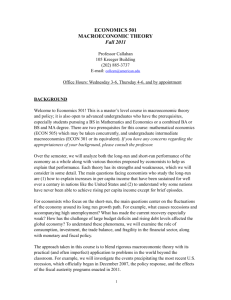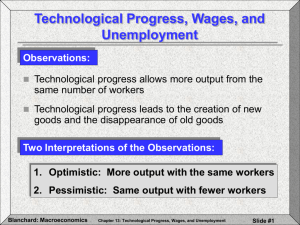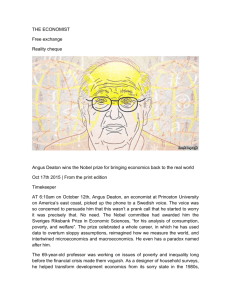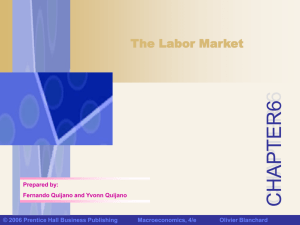418 syllabus - Francis
advertisement
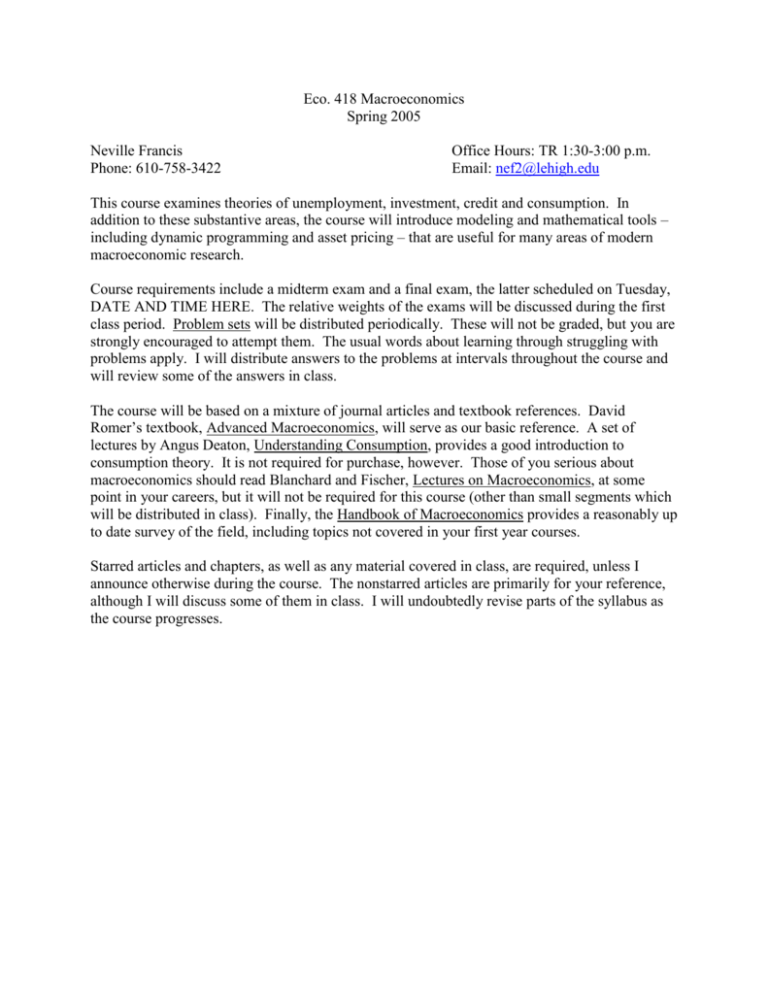
Eco. 418 Macroeconomics Spring 2005 Neville Francis Phone: 610-758-3422 Office Hours: TR 1:30-3:00 p.m. Email: nef2@lehigh.edu This course examines theories of unemployment, investment, credit and consumption. In addition to these substantive areas, the course will introduce modeling and mathematical tools – including dynamic programming and asset pricing – that are useful for many areas of modern macroeconomic research. Course requirements include a midterm exam and a final exam, the latter scheduled on Tuesday, DATE AND TIME HERE. The relative weights of the exams will be discussed during the first class period. Problem sets will be distributed periodically. These will not be graded, but you are strongly encouraged to attempt them. The usual words about learning through struggling with problems apply. I will distribute answers to the problems at intervals throughout the course and will review some of the answers in class. The course will be based on a mixture of journal articles and textbook references. David Romer’s textbook, Advanced Macroeconomics, will serve as our basic reference. A set of lectures by Angus Deaton, Understanding Consumption, provides a good introduction to consumption theory. It is not required for purchase, however. Those of you serious about macroeconomics should read Blanchard and Fischer, Lectures on Macroeconomics, at some point in your careers, but it will not be required for this course (other than small segments which will be distributed in class). Finally, the Handbook of Macroeconomics provides a reasonably up to date survey of the field, including topics not covered in your first year courses. Starred articles and chapters, as well as any material covered in class, are required, unless I announce otherwise during the course. The nonstarred articles are primarily for your reference, although I will discuss some of them in class. I will undoubtedly revise parts of the syllabus as the course progresses. I. UNEMPLOYMENT A. OVERVIEW AND SOME FACTS *Romer, Ch. 5.6 Blanchard, O. and L. Katz, “What We Know and Do Not Know About the Natural Rate of Unemployment.” The Journal of Economic Perspectives, Winter 1997, 11:1:51-72. Davis, S., J. Haltiwanger, and S. Schuh, Job Creation and Destruction, Cambridge, MA: MIT Press, 1996. Chapter 2. Solon, G., R. Barsky, and J. Parker, “Measuring the Cyclicality of Real Wages: How Important is Composition Bias?,” Quarterly Journal of Economics, 1994, 109:1:1-26. OECD Jobs Study, 1994, Evidence and Explanations, Parts I and II. B. EFFICIENCY WAGES *Romer, 9.2-9.4 *Shapiro, C. and J. Stiglitz, Equilibrium Unemployment as a Worker-Discipline Device.” American Economic Review, June 1984, 74:443-444. *Krueger, A. and L. Summers, “Efficiency Wages and the Interindustry Wage Structure.” Econometrics, March 1988, 56:259-293. *Abowd, J.M., Kramarz, F., and D.N. Margolis, “High Wage Workers and High Wage Firms.” Econometrica, 1999, 67:2, 251-333. C. SEARCH *Romer, Ch. 9.8. *Pissarides, C., Equilibrium Unemployment Theory. Oxford: Basil Blackwell, 2000. Chapter 1. Diamond, P., “Wage Determination and Efficiency in Search Equilibrium,” Review of Economic Studies, 1982, 49:2:217-27. D. UNEMPLOYMENT DYNAMICS Blanchard, O., and L. Summers, “Hysteresis in Unemployment.” European Economic Review, 1987, 31:288-295. *Mankiw, N.G., “The Inexorable and Mysterious Tradeoff Between Inflation and Unemployment,” Harry Johnson Lecture, Econometric Society, 2000. Blanchard, O., and L. Katz, “Wage Dynamics: Reconciling Theory and Evidence,” American Economic Review, May 1999, 89:69-74. II. INVESTMENT *Romer, ch. 8.1-8.4 Romer, ch. 8.5-8.8 III. CREDIT MARKETS A. IMPERFECT ASSET SUBSTITUTABILITY *Bernanke, B. and A. Blinder, “Credit, Money, and Aggregate Demand,” American Economic Review, May 1988, 78:2:435-439. B. MULTIPLE EQUILIBRIA *Diamond, D. and P. Dybvig, “Bank Runs, Deposit Insurance, and Liquidity,” Journal of Political Economy, 1983, 01:410-419. C. ASYMMETRIC INFORMATION *Bernanke, B. and M. Gertler, “Agency Costs, Net Worth, and Business Fluctuations,” American Economic Review. March 1989, 79:14-31. *Kiyotaki, N. and J. Moore, “Credit Cycles,” Journal of Political Economy, April 1997, 105:2:211-248. IV. CONSUMPTION GENERAL REFERENCE: ROMER, CH. 7 A. THE LIFE CYCLE AND PERMANENT INCOME HYPOTHESES Deaton, A., Understanding Consumption, Clarendon Press, Oxford 1992. Chapters 1 and 2. *Blanchard and Fischer, Section 2. *Carroll, C. and L. Summers, “Consumption Growth Parallels Income Growth: Some New Evidence,” in Bernheim and Shoven eds. National Saving and Economic Performance, Chicago, University of Chicago Press, 1991. 305-347. Sargent, T., Dynamic Macroeconomic Theory, Harvard University Press, 1987, Chapter 1. B. AGGREGATE CONSUMPTION FLUCTUATIONS: EXCESS SMOOTHNESS AND EXCESS SENSITIVITY Deaton, Chapters 3 and 4. *Hall, R.E., “Stochastic Implications of the Life Cycle Permanent Income Hypotheses: Theory and Evidence,” Journal of Political Economy, December 1978, 971-87. *Flavin, M., “The Excess Smoothness of Consumption: Identification and Interpretation,” Review of Economic Studies, July 1993, 60:3:651-666. Pischke, S., “Individual Income, Incomplete Information, and Aggregate Consumption,” Econometrica, July 1995, 63:4:805-840. C. PRECAUTIONARY SAVINGS, LIQUIDITY CONSTRAINTS AND BUFFER STOCK MODELS Deaton, Chapters 5 and6. *Carroll, C., “Buffer-Stock Saving and the Life Cycle/Permanent Income Hypothesis,” Quarterly Journal of Economics, February 1997. *Gourinchas, P. and J. Parker, “Consumption Over the Lifecycle,” mimeo, 1996. *Zeldes, S., “Consumption and Liquidity Constraints: An Empirical Investigation,” Journal of Political Economy, 1989, 97:305-346. Caroll, C. and M. Kimball, “On the Concavity of the Consumption Function, Econometrica. Kimball, M., Precautionary Saving in the Small and in the Large,” Econometrica, January 1990, 58:53-73. D. CONSUMPTION AND ASSET MARKETS Deaton, pp. 65-76. *Blanchard and Fisher, Section 10.1. Siegel, Jeremy J. and Richard H.Thaler, “The Equity Premium Puzzle,” Journal of Economic Perspectives. Winter 1997, 11:1:191-200. Blanchard, O., “Movements in the Equity Premium” Brookings Papers on Economic Activity, 1993,2:75-138. Campbell, John Y. and John H. Cochrane, “By Force of Habit: A ConsumptionBased Explanation of Aggregate Stock Market Behavior,” Journal of Political Economy, April 1999, 107:2:205-251. Hansen, L. and K. Singleton, “Stochastic Consumption, Risk Aversion, and the Temporal Behavior of Asset Returns,” Journal of Political Economy, 1983, 91:2:249-265. Lucas, R., “Asset Prices in an Exchange Economy,” Econometrica, December 1978, 46:1429-1445. Mehra R. and E. Prescott, “The Equity Premium: a Puzzle,” Journal of Monetary Economics, 1985, 145-162. E. HYBERBOLIC DISCOUNTING Laibson, D., “Golden Eggs and Hyperbolic Discounting,” Quarterly Journal of Economics, May 1997, 443-477.

